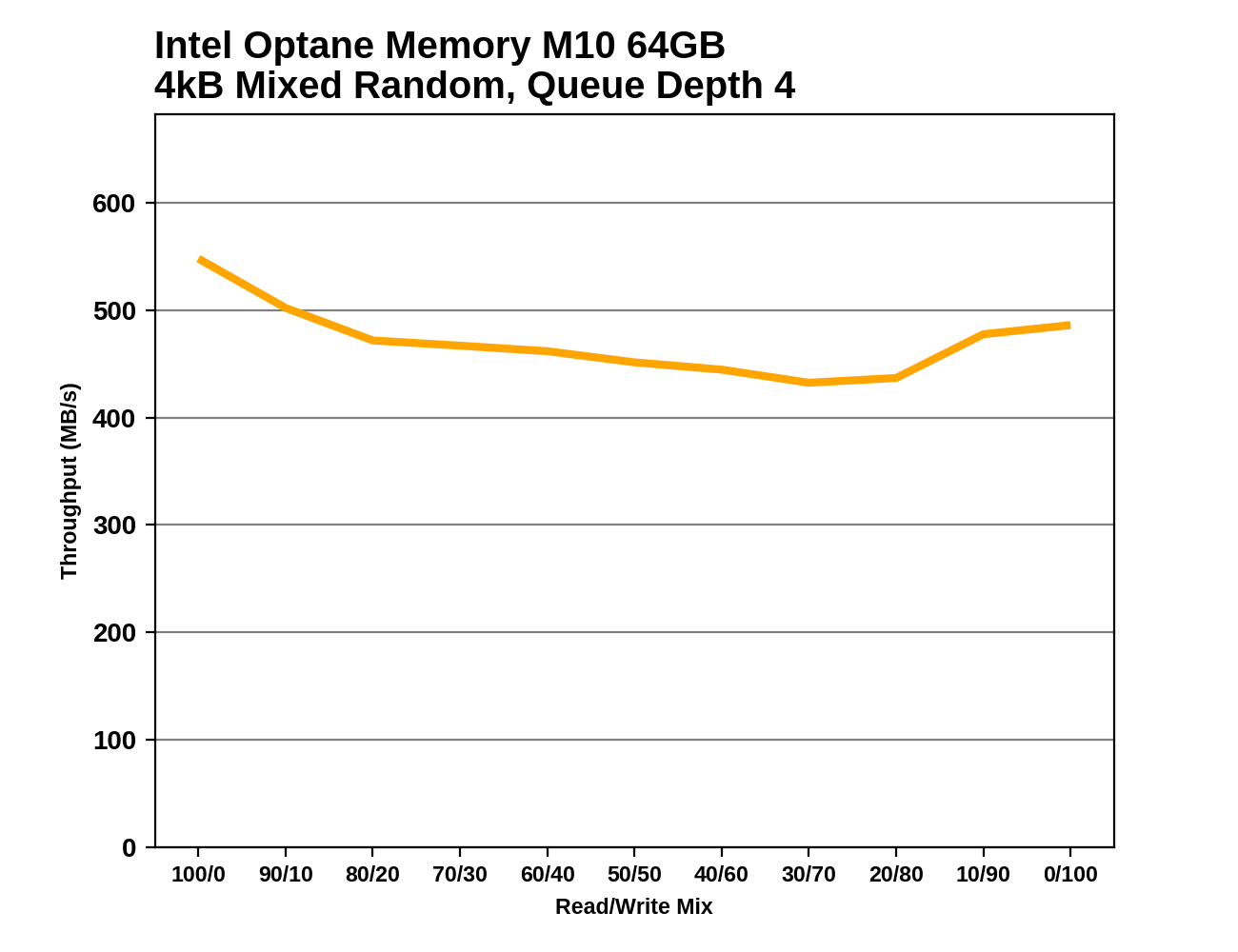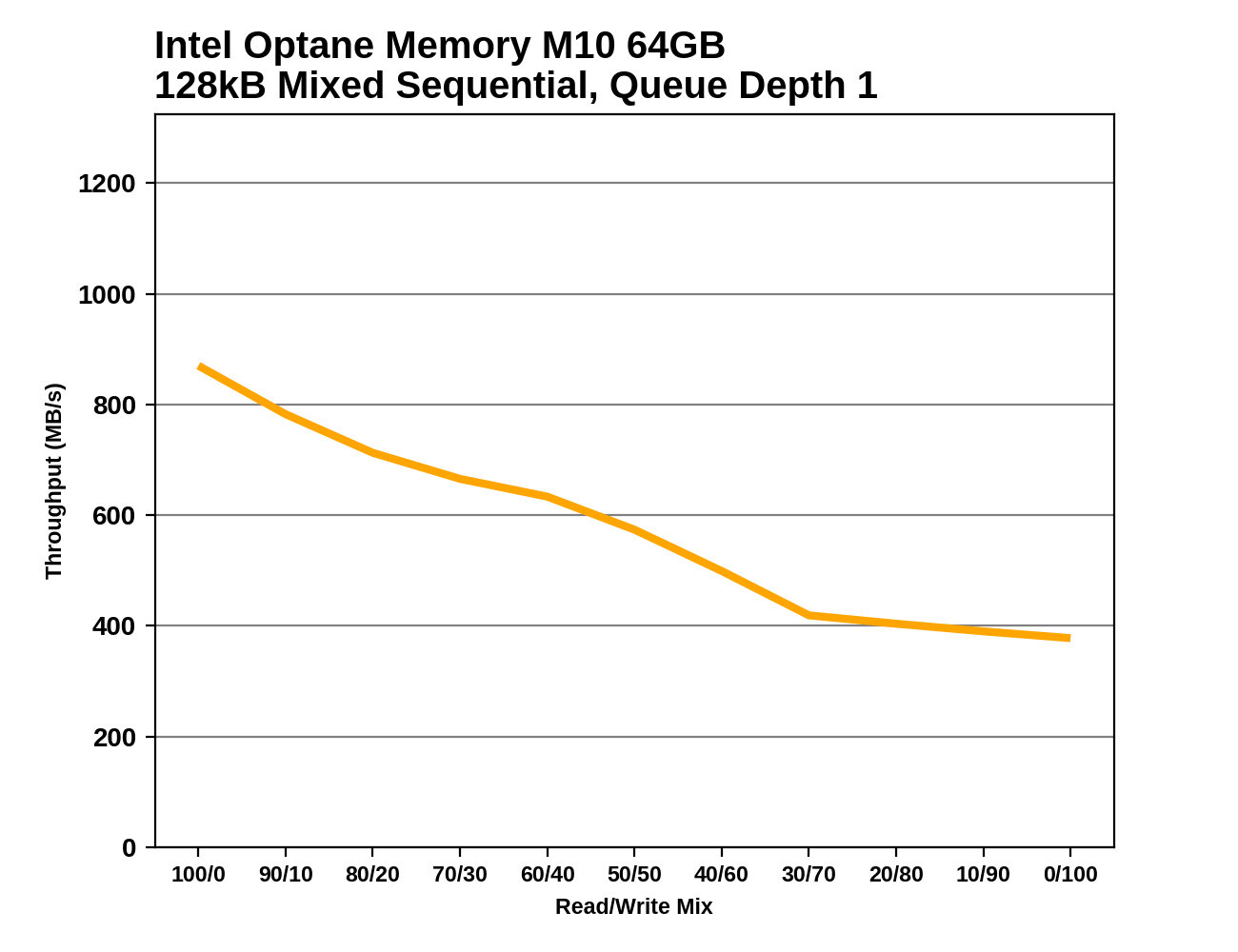The Intel Optane Memory M10 (64GB) Review: Optane Caching Refreshed
by Billy Tallis on May 15, 2018 10:45 AM EST- Posted in
- SSDs
- Storage
- Intel
- PCIe SSD
- SSD Caching
- M.2
- NVMe
- Optane
- Optane Memory
Mixed Random Performance
Our test of mixed random reads and writes covers mixes varying from pure reads to pure writes at 10% increments. Each mix is tested for up to 1 minute or 32GB of data transferred. The test is conducted with a queue depth of 4, and is limited to a 64GB span of the drive. In between each mix, the drive is given idle time of up to one minute so that the overall duty cycle is 50%.

Unsurprisingly, the mixed random I/O test produces crap performance from the hard drive and the two cache configurations where the cache is too small for this test. The 118GB Optane SSD 800P is more cache than this test needs, and it performs almost as well as the Optane SSD 900P.
 |
|||||||||
When used as a cache for this test, the largest Optane SSD 800P shows slightly different performance characteristics than when it is treated as a standalone drive, but in either case it is a strong performer across the board. The smaller Optane drives aren't large enough to cache the entire working set of this test and can't do much to improve performance over the hard drive.
Mixed Sequential Performance
Our test of mixed sequential reads and writes differs from the mixed random I/O test by performing 128kB sequential accesses rather than 4kB accesses at random locations, and the sequential test is conducted at queue depth 1. The range of mixes tested is the same, and the timing and limits on data transfers are also the same as above.

All of the Optane configurations easily outperform the SATA drives on the mixed sequential I/O test. The 64GB and 118GB modules are tied when tested as standalone drives and close when tested as cache devices, and the cache performance is 30-40% faster than the standalone SSD performance. The 32GB module is substantially slower and performance is much closer between caching and standalone SSD use.
 |
|||||||||
The performance improvements in the caching configurations over the standalone drive configurations generally apply throughout the mixed sequential test. The main exception is in the early phases of the test with the 32GB cache, where cache performance falls far short of the standalone drive performance. Once the proportion of reads has dropped to 70%, the cache configuration comes out ahead.










96 Comments
View All Comments
FunBunny2 - Wednesday, May 16, 2018 - link
one of the distinguishing points, so to speak, of XPoint is its byte-addressable protocol. but I've found nothing about the advantages, or whether (it seems so) OS has to be (heavily?) modified to support such files. anyone know?Billy Tallis - Wednesday, May 16, 2018 - link
The byte-addressability doesn't provide any direct advantages when the memory is put behind a block-oriented storage protocol like NVMe. But it does simplify the internal management the SSD needs to do, because modifying a chunk of data doesn't require re-writing other stuff that isn't changing. NVDIMMs will provide a more direct interface to 3D XPoint, and that's where the OS and applications need to be heavily modified.zodiacfml - Friday, May 18, 2018 - link
Quite impressive but for 32GB Optane drive, I can have a 250 GB SSD.The Optane might improve performance for fractions of a second over SSDs for applications but it won't help during program/driver installations or Windows updates which needs more speed.
I'd reconsider it for a 64 GB Optane as a boot drive for the current price of the 32GB.
RagnarAntonisen - Sunday, May 20, 2018 - link
You've got to feel for Intel. They spend a tonne of cash on projects like Larrabee, Itanium and Optane and the market and tech reviewers mostly respond with a shrug.And then everyone complains they're being complacent when it comes to CPU design. Mind you they clearly were - CPU performances increased at a glacial rate until AMD released a competitive product and then there was a big jump from 4 cores to 6 in mainstream CPUs with Coffee Lake. Still if the competition was so far behind you can afford to direct to R&D dollars to other areas.
Still it all seems a bit unfair - Intel get criticised when they try something new and when they don't.
And Itanium, Larrabee and Optane all looked like good ideas on paper. It was only when they had a product that it became clear that it wasn't competitive.
Adramtech - Sunday, May 20, 2018 - link
since when is a 1st or 2nd Gen product competitive? I'm sure if they don't have a path to reach competitiveness, the project will be scrapped.Keljian - Tuesday, May 29, 2018 - link
While I don't doubt the tests are valid, I would really like to see a test with say PrimoCache - with the blocksize set to 4k. I have found in my own testing that Optane (with PrimoCache using optane as an L2 @ 4k) is very worthwhile even for my Samsung 950 pro.Keljian - Tuesday, May 29, 2018 - link
https://hardforum.com/threads/intel-900p-optane-wo... - Here are my benchmark findings for the 850 evo and 950 pro using the 32gb optane as L2 cache. You'll notice the 4k speeds stand out.denywinarto - Tuesday, May 29, 2018 - link
Thinking of using this with 12 tb hgst for a gamedisk drive for a ISCSI-based server, the data read is usually the same as they only game files. But occasionally new game gets added. Would it be a better option compared to raid? SSD are too expensive.Lolimaster - Monday, October 1, 2018 - link
Nice to use the 16GB as pagefile, chrome/firefox profile/cacheLolimaster - Tuesday, October 2, 2018 - link
It's better to use them as extra ram/pagefile or scratch disk.